When you open AI Governance, you arrive at the Overview page. Across the top of the page are links to other AI Governance product pages, including the AI use case, AI model, and AI Agent registries.
| Design priority | Objective |
|---|---|
| Quickly track and manage all AI assets in one place. | Boost transparency, consistency, and control across teams. |
| Bring AI use cases, AI models, and AI Agents into a governed lifecycle. | Help track the evolution of AI use cases, the AI models and AI agents they use, and the data used by AI models. |
| Connect AI use cases to AI models and AI agents, data, and policies. | Ensure audit and regulatory readiness. |

Click the following tabs to view page-specific information.
The AI Governance Overview page allows you to view up to 50 existing AI use cases, search for AI use cases, and register new AI use cases.
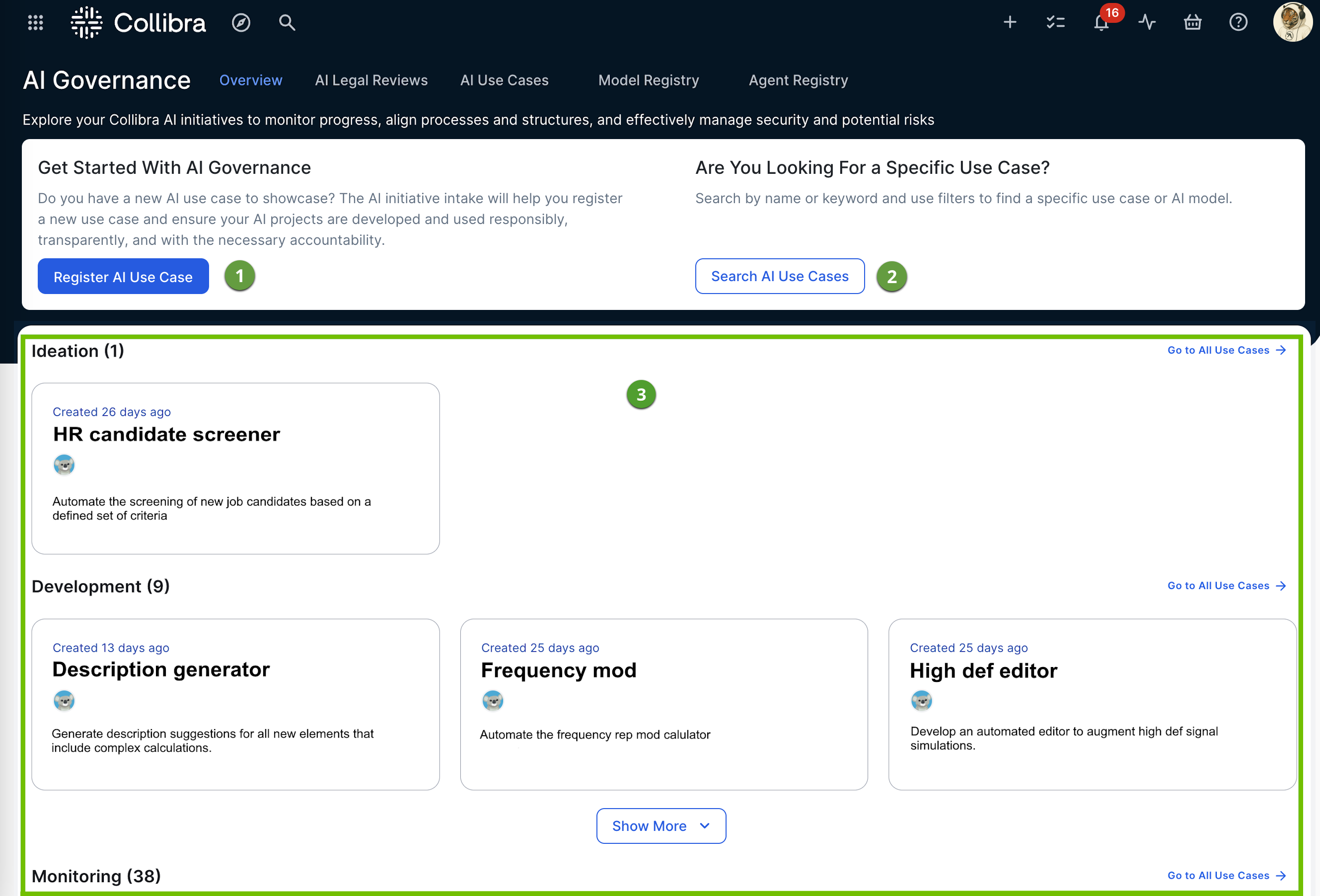
| No. | Element | Description |
|---|---|---|
|
|
Register AI Use Case button |
By default, opens the Register AI Use Case dialog box. You can, however, configure the button to start a workflow. For complete information, go to Set up AI Governance. Note If you don't have a global role with the AI Governance > Register AI Use Case global permission, the button does not appear on the page. Tip You can also create an AI Use Case asset via the global Create button. When you create an asset that way, no assessments are started. This is helpful if you want to add details to the various sections of the asset page, without the values being overwritten by an assessment. |
|
|
Search AI Use Cases |
Open the Search page. The asterisk (*) wildcard search is run with a filter applied for th AI Use Case asset type, meaning all existing AI Use Case assets are shown in the search results. |
|
|
Use cases |
View of all AI use cases in your Collibra environment, organized by status. The statuses by which assets are organized on this page are determined by the asset statuses that are included in the AI Use Case asset type core path. If you edit the core path, the changes are reflected on the Overview page. For more information, go to Configure AI Governance asset statuses. Assets with the status Archived don't appear on the Overview page, even if the status Archived is included in the AI Use Case asset type core path. Tip For information on advancing the status, or lifecycle stage, of an AI use case, go to Lifecycle tracker. |
The AI Legal Reviews page allows you to start assessments on new AI use cases, monitor existing and newly created use cases, register new use cases, and see which review tasks are awaiting action from you.
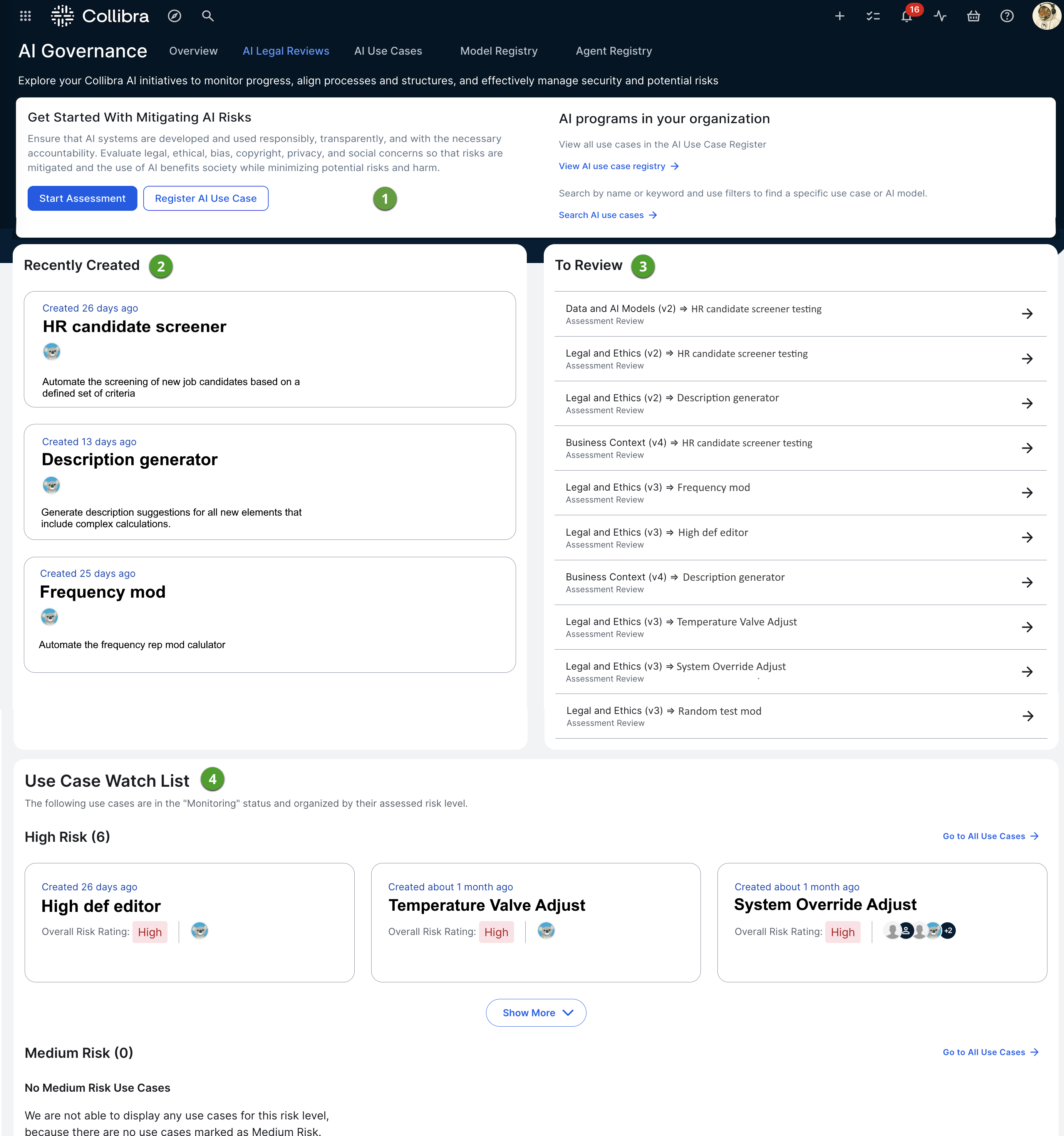
| No. | Element | Description |
|---|---|---|
|
|
Start Assessment button |
Starts a Legal and Ethics assessment. For more information, go to Conduct an assessment of an AI Governance asset. Tip You can also start any of the assessments from the Lifecycle tracker. |
| Register AI Use Case button | By default, opens the Register AI Use Case dialog box. You can, however, configure the button to start a workflow. For complete information, go to Set up AI Governance. Note If you don't have a global role with the AI Governance > Register AI Use Case global permission, the button does not appear on the page. You can also create an AI Use Case asset via the global Create button. When you create an asset that way, no assessments are started. This is helpful if you want to add details to the various sections of the asset page, without the values being overwritten by an assessment. |
|
|
View and search for AI use cases |
Click View AI use case registry to open a view of the AI Governance domain. Click Search AI Use Cases to open the Search page. The asterisk (*) wildcard search is run with a filter applied for th AI Use Case asset type, meaning all existing AI Use Case assets are shown in the search results. |
|
|
|
Recently Created |
Shows the three most recently registered AI use cases. |
|
|
To Review |
Shows the Assessment Review assets for which you have an approval task pending. The oldest tasks are shown, up to a maximum of 10. Click a review item to open the respective Assessment Review asset page. Note Tasks related to Assessment Review assets that have the status New, Accepted, Rejected, or Obsolete do not appear in this list. |
|
|
Use Case Watch List |
Shows existing AI use cases, grouped by risk level. This section shows only the AI use cases that are in the last stage of the AI use case lifecycle; in other words, the last asset status in the core path. For more information on the lifecycle stages of an AI use case, the core path, and configuring the asset status progression, go to: You can use the following risk rating definitions to help guide your risk assessment of your AI use cases.
Note These risk ratings are not derived or calculated. They reflect your answer – high, medium, or low – to a question in the out-of-the-box Risks and Safeguards assessment. |
The AI Use Cases page allows you to view and search across all existing AI use cases.
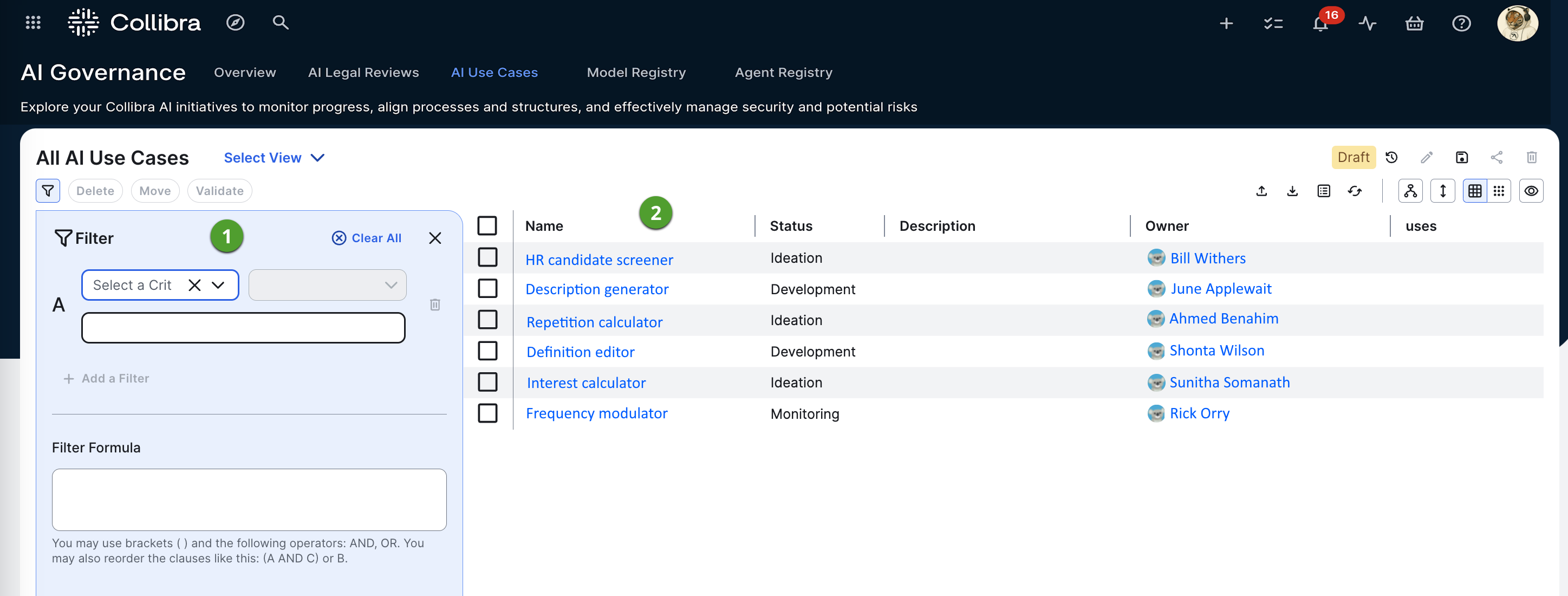
| No. | Element | Description |
|---|---|---|
|
|
AI use case filter |
The asset filter enables you to quickly find the AI use cases you want by limiting the number of AI Use Case assets shown in the view. |
|
|
Asset view |
Asset view of all AI use cases, taking into account the selected view and any configured filters. To apply a different asset view, click Select View and select a view. You can also copy views, share views, and more, from this page. For complete information on working with asset views, go to Views.
As shown in the following image, if you select one or more AI use cases, you are presented with options to delete or move the AI use case to a different domain, or start a workflow.
|
The Model Registry page allows you to track, review, and manage all Al models (and assets of child asset types) in your Collibra environment, for better transparency and compliance.
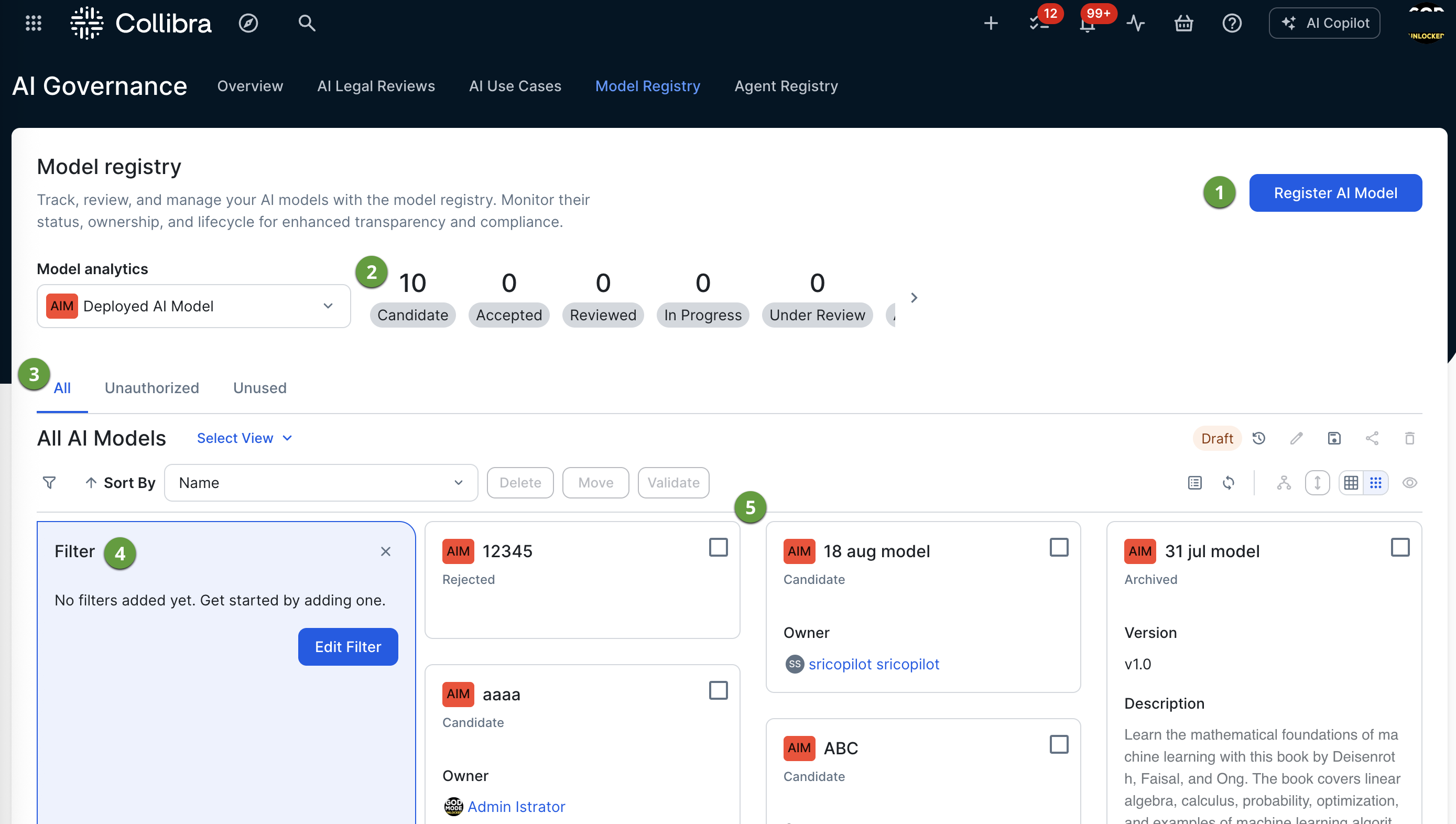
| No. | Element | Description |
|---|---|---|
|
|
Register AI model button |
Opens the Register AI Model dialog box. Note If you don't have a global role with the AI Governance > Register AI Model global permission, the button does not appear on the page. |
|
|
Model analytics |
Shows the count of AI models in your Collibra environment, by asset type and asset status. Click See more, to expand the panel:
For complete information, go to Configure the lifecycle stages of AI Governance asset types. |
|
|
All / Unauthorized / Unused view |
Asset view that allows you to quickly identify:
|
|
|
AI model filter |
The asset filter enables you to quickly find the AI models you want, by limiting the number of AI Model assets shown in the view. |
|
|
Asset view |
Asset view of all AI models, taking into account the selected view and any configured filters. To apply a different asset view, click Select View and select a view. You can also copy views, share views, and more, from this page. For complete information on working with asset views, go to Views. You can sort the AI Model assets by the following characteristics:
As shown in the following image, if you select one or more AI models, you are presented with options to delete or move the AI model to a different domain, or start a workflow.
|
The Agent Registry page allows you to track, review, and manage all Al agents (and assets of child asset types) in your Collibra environment, for better transparency and compliance.
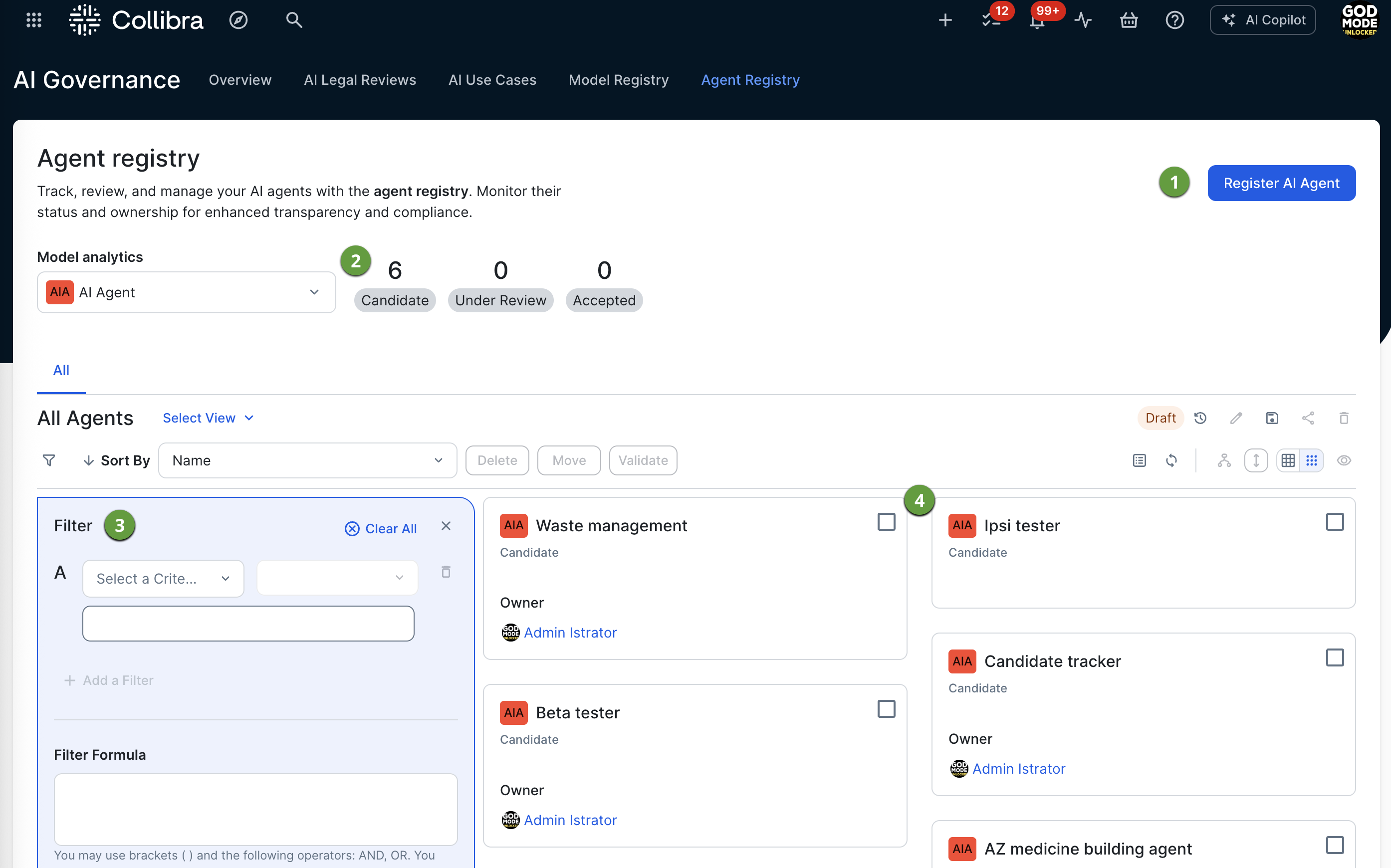
| No. | Element | Description |
|---|---|---|
|
|
Register AI Agent button |
Opens the Register AI agent dialog box. Note If you don't have a global role with the AI Governance > Register AI Agent global permission, the button does not appear on the page. |
|
|
Model analytics |
Shows the count of AI models in your Collibra environment, by asset type and asset status. Click See more, to expand the panel:
For complete information, go to Configure the lifecycle stages of AI Governance asset types. |
|
|
AI agent filter |
The asset filter enables you to quickly find the AI agents you want, by limiting the number of AI Agent assets shown in the view. |
|
|
Asset view |
Asset view of all AI agents, taking into account the selected view and any configured filters. To apply a different asset view, click Select View and select a view. You can also copy views, share views, and more, from this page. For complete information on working with asset views, go to Views. You can sort the AI Agent assets by the following characteristics:
As shown in the following image, if you select one or more AI models, you are presented with options to delete or move the AI model to a different domain, or start a workflow.
|







